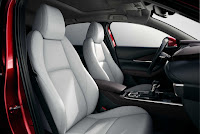As carmakers all give their vehicles a sense of dynamism, Mazda challenged themselves to come up with a design that’s hard to mimic. Thus, from embodying movement, the carmaker has instead embraced Japanese aesthetic. In creating the CX-30, they’ve embodied Yohaku or the beauty of empty space.
Based on traditional Buddhist teachings, empty space isn’t a lack; instead, it’s an energetic field of infinite potentiality. It’s this potentiality that brings energy to that empty space, contributing structure, balance, and definition. It’s this potentiality that the CX-30 unlocks: it’s an SUV that’s made to become an essential partner in their owner’s lives.
Evoking creativity in one’s life, the CX-30 realizes two contrasting expressions: the flowing beauty of a coupe and the bold proportions of an SUV. Mazda’s signature wing takes on a sharper and deeper form to achieve a strong, refined front end, suggestive of forward motion. The diagonal angle of the rear window gives the vehicle a coupe-like silhouette while the narrowed arch shape of the liftgate makes the body look shorter and wider for a powerful stance. This allows for a purposeful design of the trunk that maintains its usefulness without giving the CX-30 a box-like appearance.
Beyond mere beauty, the interior focuses on the most important aspect of all: the occupants. For the driver, the seat cushion maintains the spine’s natural curvature while also being setting up in a way that provides a clear field of view of the road ahead. The controls have all been optimized for operating stability, ease, and comfort—down to the use of consistent lighting and font types.
For the passengers, ingenious details like slightly slanting the rear foot well provide them with more foot and knee room, while subtly rounding the side sill in the door jams ensure comfort when entering or exiting, while not creating a gap in the door seams. Designers have gone as far as creating a life-size test model just to optimize the height of the CX-30’s trunk release button.
Mazda’s decision to put Japanese aesthetic front-and-center in their design comes at a time when efficiency has ruled mankind’s daily life. However, because they want to create a deeper bond between car and driver, they instilled a sense of richness to their design, some of which may not be noticed right away. Regardless, this is the best way to enrich the experience of driving and owning a CX-30—an SUV made as a celebration to all of life’s potentiality.
Paid Advertorial.










No comments:
Post a Comment